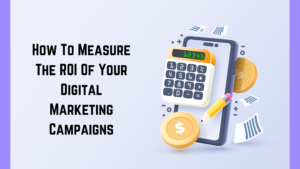In today’s digital-first world, online advertising is no longer just about driving direct sales. For brands without e-commerce websites, it might feel like a challenge to justify ad spend when there’s no immediate “Add to Cart” moment. However, the true power of online advertising lies in the rich data it generates—a goldmine for building communities, deepening customer relationships, and optimizing Return on Ad Spend (ROAS) in the long run.
Here’s how brands can strategically use this data to grow and thrive, even without an online storefront.
1. Harness Audience Insights To Build A Loyal Community
Every ad interaction—clicks, views, shares, or even time spent engaging—offers valuable insights about your audience’s preferences, behaviors, and interests.
Steps to build your community using data:
- Create personalized content: Use demographic, interest, and behavioral data from your campaigns to design tailored content that resonates with your audience.
- Leverage retargeting: Engage those who interacted with your ads by inviting them to join your social media communities, subscribe to newsletters, or participate in surveys.
- Start meaningful conversations: Data can reveal pain points and preferences. Use this to initiate dialogues through social media posts or webinars to keep your audience engaged.
Pro Tip:
Offer incentives like exclusive behind-the-scenes content, loyalty programs, or first access to events. This gives your audience a reason to stay connected.
2. Segment And Understand Your Audience For Targeted Campaigns
Without an e-commerce website, understanding what appeals to your audience is crucial for optimizing your ad spend. Segmentation is key.
How segmentation helps:
- Group your audience by attributes like age, location, and interests.
- Run campaigns tailored to each segment to increase engagement rates.
- Use heatmap tools or polls to identify high-performing content.
This approach ensures that your message reaches the right people, improving campaign efficiency and reducing wasted ad spend.
3. Drive Offline Conversions With Hyper-Localized Campaigns
For businesses with physical stores or service-oriented models, online ads can still play a critical role in driving footfall.
Strategies to implement:
- Geo-targeting: Show ads to audiences within a specific radius of your store or service area.
- Call-to-action (CTA): Use CTAs like “Visit us today,” “Call now,” or “Book an appointment” to drive action.
- Trackable offers: Provide digital coupons or QR codes that can be redeemed in-store to measure the effectiveness of your campaigns.

4. Build First-Party Data For Future Campaigns
Data privacy regulations are becoming stricter, making first-party data a brand’s most valuable asset. Every interaction—be it through a lead form, social media follow, or survey response—helps you build a proprietary database.
Ways to collect and use first-party data:
- Lead generation ads: Collect contact information for future outreach.
- Events and webinars: Host events to interact directly with your audience while gathering preferences.
- Surveys: Use surveys to understand customer needs while creating a sense of involvement.
By building a strong database, you’re not just planning for today but preparing for long-term success.
5. Leverage Lookalike Audiences For Future Growth
Platforms like Facebook and Google Ads allow you to create lookalike audiences based on existing user data. Even if you don’t sell online, these tools help you reach potential customers with similar profiles to your existing audience.
How to use lookalike audiences effectively:
- Focus on high-value segments, such as users who have interacted the most with your ads.
- Test different ad creatives to see what works best.
This strategy helps you grow your community and expand your reach without overshooting your budget.
6. Optimize ROAS With Continuous Analysis And Testing
Data without action is just noise. Regularly analyze your campaign data to understand what’s working and what’s not.
Key metrics to monitor:
- Engagement rate: How many users are interacting with your content?
- Conversion rate: How many users are taking your desired action (e.g., signing up for newsletters, visiting stores)?
- Cost per lead (CPL): Are you spending efficiently?
Use A/B testing to refine your creatives, targeting, and CTAs. Over time, these refinements will lead to better ROAS and stronger audience engagement.

Frequently Asked Questions (FAQs)
1. Why is advertising data important for brands?
It helps brands understand customer behavior, ad performance, and ROI.
2. What kind of data do online ads provide?
Impressions, clicks, conversions, cost-per-click, audience demographics, and behavior.
3. How can brands use this data?
To refine targeting, optimize campaigns, improve messaging, and boost returns.
4. What tools help analyze ad data?
Google Ads, Meta Ads Manager, Google Analytics, and third-party attribution tools.
5. Is real-time data useful?
Yes, it allows quick adjustments to campaigns for better performance.
6. Can small businesses benefit from ad data?
Absolutely—data-driven insights help even small brands spend smarter and grow faster.
7. How often should brands analyze their ad data?
Regularly—ideally weekly or bi-weekly for continuous optimization.
Final Thoughts
Even without an e-commerce website, online advertising offers endless possibilities for brands to build loyal communities, enhance customer relationships, and maximize ROI. The key lies in using data strategically to understand your audience, engage them meaningfully, and optimize your campaigns continuously.
The journey from “view” to “value” might take longer, but the results are worth the effort. When done right, you’re not just creating ads—you’re creating advocates.
What’s your strategy for using online advertising data? Let’s connect and explore how your brand can grow smarter and faster.
Also read:
- Customer Retention For D2C Brands: The Secret Weapon To Sustainable Growth
- How Businesses Can Create Omnichannel Customer Experiences
- Top Google Ads Mistakes To Avoid In 2025
- Content Creation vs. Content Distribution: The Two Sides Of Social Media Success





